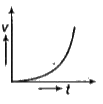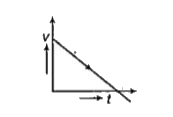A
B
C
D
Text Solution
Verified by Experts
The correct Answer is:
|
Topper's Solved these Questions
GENERAL KINEMATICS AND MOTION IN ONE DIMENSION
A2Z|Exercise Relative Motion In One Dimension|20 VideosView PlaylistGENERAL KINEMATICS AND MOTION IN ONE DIMENSION
A2Z|Exercise Understanding Motion Through Graphs|40 VideosView PlaylistGENERAL KINEMATICS AND MOTION IN ONE DIMENSION
A2Z|Exercise Motion With Constant Acceleration|30 VideosView PlaylistFLUID MECHANICS
A2Z|Exercise Chapter Test|29 VideosView PlaylistGRAVITATION
A2Z|Exercise Chapter Test|29 VideosView Playlist
Similar Questions
Explore conceptually related problems
Knowledge Check
A
B
C
D
Submit
A
B
C
D
Submit
A
B
C
D
Submit
Similar Questions
Explore conceptually related problems
A2Z-GENERAL KINEMATICS AND MOTION IN ONE DIMENSION-Motion Under Gravity
- A ball is thrown straight up in the air. For which situation are both ...
01:42
|
Play - A body is dropped from a certain height.
02:55
|
Play - A ball is thrown vertically upwards under the influence of gravity. Su...
03:19
|
Playing Now - Two balls A and B of same masses are thrown from the top of the buildi...
03:15
|
Play - You drop a ball from a window located on an upper floor of a building....
06:25
|
Play - A pebble is released from rest at a certain height and falls freely, r...
03:17
|
Play - A pebble is dropped from rest from the top of a till cliff and falls 4...
03:24
|
Play - A ball is released from the top of a tower of height h meters . It tak...
02:15
|
Play - A ball is upward with such a velocity v that it returns to the thrower...
03:03
|
Play - A stone is thrown upwards with a velocity 50 ms^-1. Another stone is s...
03:14
|
Play - An object is dropped from a height h. Then the distance travelled in t...
03:15
|
Play - A body is thrown vertically upward with velocity u. The ratio of times...
08:21
|
Play - A body is dropped from a height h. If t1 and t2 be the times in coveri...
03:08
|
Play - A body projected vertically upwards with a given velocity. The ratio o...
04:32
|
Play - A man in a balloon rising vertically with an acceleration of 5 ms^-2 r...
04:22
|
Play - A ball projected upwards from the foot of a tower. The ball crosses th...
04:23
|
Play - From the top of the tower of height 400 m, a ball is dropped by a man,...
03:30
|
Play - A stone falls freely from rest from aheight h and it travels a distanc...
03:39
|
Play - A stone is thrown upwards from the top of a tower with some initial sp...
05:23
|
Play - A body is projected vertically upwards with some velocity u. It is at ...
03:18
|
Play



